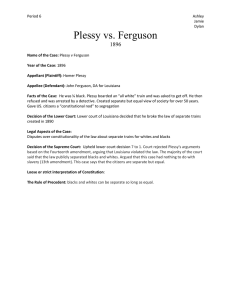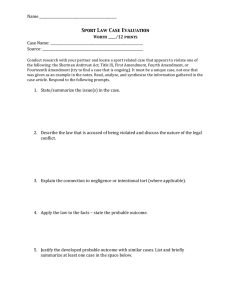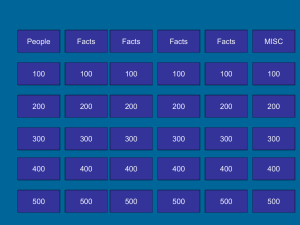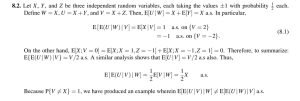Chapter Focus Chapter 6: Civil Rights
advertisement
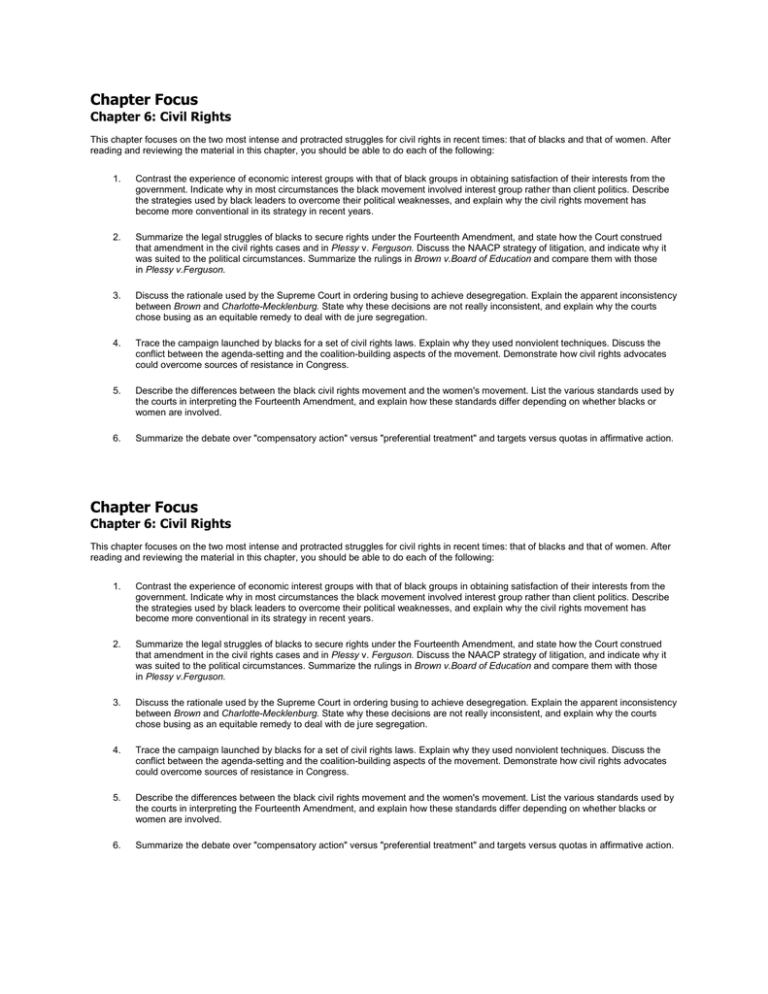
Chapter Focus Chapter 6: Civil Rights This chapter focuses on the two most intense and protracted struggles for civil rights in recent times: that of blacks and that of women. After reading and reviewing the material in this chapter, you should be able to do each of the following: 1. Contrast the experience of economic interest groups with that of black groups in obtaining satisfaction of their interests from the government. Indicate why in most circumstances the black movement involved interest group rather than client politics. Describe the strategies used by black leaders to overcome their political weaknesses, and explain why the civil rights movement has become more conventional in its strategy in recent years. 2. Summarize the legal struggles of blacks to secure rights under the Fourteenth Amendment, and state how the Court construed that amendment in the civil rights cases and in Plessy v. Ferguson. Discuss the NAACP strategy of litigation, and indicate why it was suited to the political circumstances. Summarize the rulings in Brown v.Board of Education and compare them with those in Plessy v.Ferguson. 3. Discuss the rationale used by the Supreme Court in ordering busing to achieve desegregation. Explain the apparent inconsistency between Brown and Charlotte-Mecklenburg. State why these decisions are not really inconsistent, and explain why the courts chose busing as an equitable remedy to deal with de jure segregation. 4. Trace the campaign launched by blacks for a set of civil rights laws. Explain why they used nonviolent techniques. Discuss the conflict between the agenda-setting and the coalition-building aspects of the movement. Demonstrate how civil rights advocates could overcome sources of resistance in Congress. 5. Describe the differences between the black civil rights movement and the women's movement. List the various standards used by the courts in interpreting the Fourteenth Amendment, and explain how these standards differ depending on whether blacks or women are involved. 6. Summarize the debate over "compensatory action" versus "preferential treatment" and targets versus quotas in affirmative action. Chapter Focus Chapter 6: Civil Rights This chapter focuses on the two most intense and protracted struggles for civil rights in recent times: that of blacks and that of women. After reading and reviewing the material in this chapter, you should be able to do each of the following: 1. Contrast the experience of economic interest groups with that of black groups in obtaining satisfaction of their interests from the government. Indicate why in most circumstances the black movement involved interest group rather than client politics. Describe the strategies used by black leaders to overcome their political weaknesses, and explain why the civil rights movement has become more conventional in its strategy in recent years. 2. Summarize the legal struggles of blacks to secure rights under the Fourteenth Amendment, and state how the Court construed that amendment in the civil rights cases and in Plessy v. Ferguson. Discuss the NAACP strategy of litigation, and indicate why it was suited to the political circumstances. Summarize the rulings in Brown v.Board of Education and compare them with those in Plessy v.Ferguson. 3. Discuss the rationale used by the Supreme Court in ordering busing to achieve desegregation. Explain the apparent inconsistency between Brown and Charlotte-Mecklenburg. State why these decisions are not really inconsistent, and explain why the courts chose busing as an equitable remedy to deal with de jure segregation. 4. Trace the campaign launched by blacks for a set of civil rights laws. Explain why they used nonviolent techniques. Discuss the conflict between the agenda-setting and the coalition-building aspects of the movement. Demonstrate how civil rights advocates could overcome sources of resistance in Congress. 5. Describe the differences between the black civil rights movement and the women's movement. List the various standards used by the courts in interpreting the Fourteenth Amendment, and explain how these standards differ depending on whether blacks or women are involved. 6. Summarize the debate over "compensatory action" versus "preferential treatment" and targets versus quotas in affirmative action.

